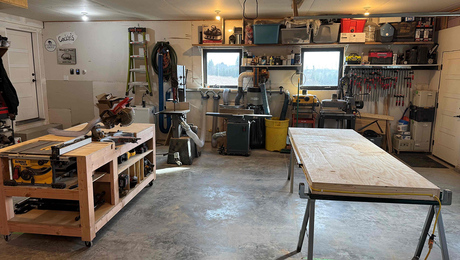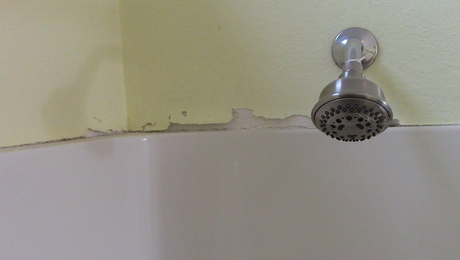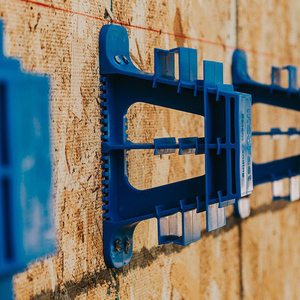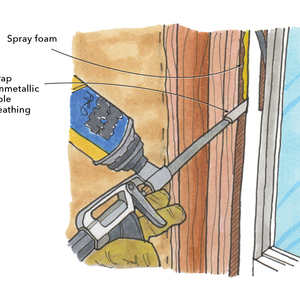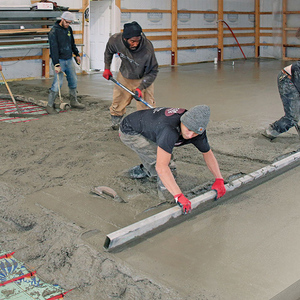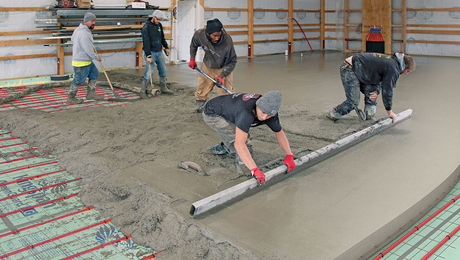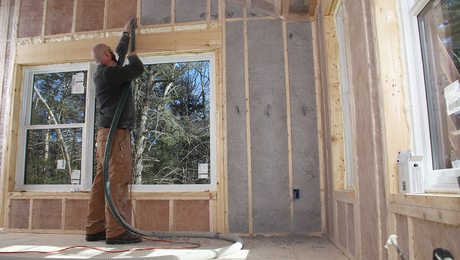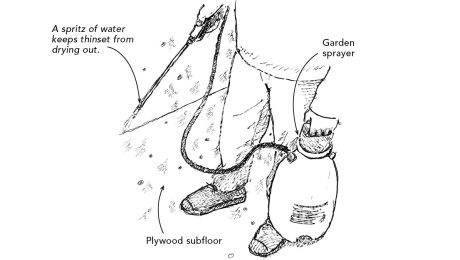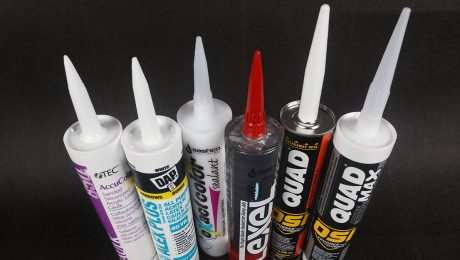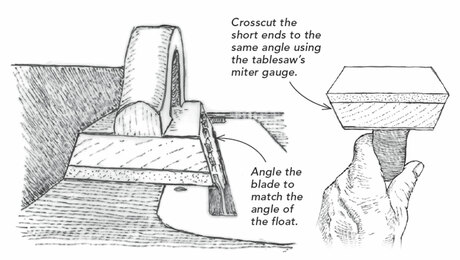Podcast 485: Air-Sealing a Mobile Home, Owner/Builder Tests, and Ready-to-Tile Shower Bases
Brian Pontolilo, Ian, and Patrick hear from listeners about hygric buoyancy and wet basement floors before taking listener questions about air-sealing the floor of a vintage mobile home, taking building tests, and the right mortar for ready-to-tile shower pans.
Follow the Fine Homebuilding Podcast on your favorite app. Subscribe now and don’t miss an episode:
 |
Help us make better episodes and enter for a chance to win an FHB Podcast T-shirt:
www.finehomebuilding.com/podcastsurvey
Doug and James share knowledge on the density of humid versus dry air. Roger asks for clarification about water moving through concrete. Jerry has a solution for air-sealing electrical boxes. Matt asks for advice air-sealing and insulating his mobile-home floor. Kevin explains about building tests in British Columbia. Will asks if a wood fireplace is useful as a backup heating source. Doug asks about the right mortar for a Tile Redi shower pan.
Editor Updates:
- Brian’s house update
- Ian’s Portland trip and airport ceiling drywall system
- Jeff’s Fine Woodworking shoot for Dovetail Bootcamp
Listener Feedback 1:
Doug writes: Here’s the Lstiburek article on moisture accumulation at the top of foam attics. The reason humid air is less dense is that water molecules weigh less than nitrogen and oxygen molecules (which make up most of the atmosphere). Each molecule “takes up” the same space in the gas (at a given temperature & pressure, and the more of these lighter water molecules there are, the lighter the air.
Related Links:
James from Meta writes: Hey podcast crew, To keep the controversy going: yes, moist air is more buoyant than dry air.
When Steven wrote in claiming to debunk hygric buoyancy, he missed a couple important things:
– The molecular mass of water vapor is much lower than the bulk of the other gasses in our atmosphere: N2 weighs 28.2 g/mol. O2 weighs 32.0 g/mol. H2O only weighs 18.02 g/mol.
– Those psychrometric charts show humidity increasing pressure because they’re keeping the volume of dry air constant while adding more water vapor. That’s a pretty straightforward application of the ideal gas law: PV = nRT, so P goes up when you increase n while keeping R, T, and V constant.
Also, he added some snark about how the oceans and lakes would be above us if hygric buoyancy was a real effect, but that’s what clouds are! Maybe Steven has been spending too much time in the Southwest and forgot that those of us in more temperature climates frequently have these funny masses of water vapor floating way above us. 😉
I’ll also add that the idea that moist air is denser is an extremely common misconception. Back when I was a freshman physics major, my professor called me out for being the only student to answer the hygric buoyancy question on our exam correctly.
And to toss on a bit more physics: gas pressure and gas buoyancy are separate measures. In order for a hot air balloon to stay inflated, the gas pressure inside the balloon needs to be as high or higher than the air surrounding it. Despite having greater pressure than the surrounding air, the balloon still floats because the gas inside is less dense.
Listener Feedback 2:
Roger in Louisville, NE writes: Thinking about the wet basement bunker it appears that it has moisture coming in from outside since he says that the moisture is UNDER the rubber mats. I have read that sealing an impermeable sheet to the floor and checking for moisture is the definition of a wet basement.
Since he says that he has worked at fixing the groundwater intrusion problems I would hope that he has the proper slopes away from the house, gutter downspouts and exterior drainage in good shape. Since there is still plenty of moisture under the slab either more needs to be done or it’s possible that he is dealing with a high water table. If the house is on enough of a sidehill to have a walk-out basement it could be possible to add more drainage to the front and side of the house or even some passive drainage underneath the slab that could go to daylight.
It might also be possible to add a sump pump with an airtight lid that would relieve the hydraulic pressure from under the slab. It just seems that covering the floor with a moisture or vapor barrier with no place for the water to go after coming through the slab is just asking for future problems.
The best thing we did when doing an addition to our house over 30 years ago was to put a drain tile on the uphill side of the whole house as low on the foundation as we could and also put the gutters into a buried line. Completely solved our problems at very low cost.
Many thanks for a great show.
Related Links:
Listener Feedback 3:
Jerry writes: I was listening to episode 477 about air sealing electric boxes on exterior walls. We’ve used a product I’ve heard called putty pads. They are 8″x8″ fireblocking pads, kind of like a sheet of sticky playdough. They can be formed around the back of an outlet and used to seal air gaps. I think 3M makes them, and last we bought them you can get 20 for around $100.
Related Links:
- Amazon.com: SpecSeal SSP Putty Pads
- Straightforward Air-Sealing Strategies
- Easy-to-Air-Seal Electrical Box
Question 1: How to best keep condensation away from the floor joists on a mobile home?
Matt writes: Hello FHB: I’m a long-time listener and subscriber that has spent 21-years remodeling a vintage Marshfield Mobile Home in Wisconsin (It may date to 1968). I’m contemplating retirement and may be spending more time there in the colder weather. This potentiality motivated me to crawl under the trailer and finish the tear out that 50 plus years hadn’t completed. I started the work in mid-April when the trailer was still relatively cold compared to the ground. Consequently, the R19 mineral wool and fiberglass insulation developed condensation. I placed 2” of FOAMULAR over several areas at the time but, the majority was left open until I returned in mid-June. I had to tear out one section of the FOAMULAR as it proved unable to support my trailer leveling effort. The mineral wool underneath was wet to the point that I checked the roof for leaks. No leaks.
I made an effort to friction fit the FOAMULAR as tights as possible and match factory edges whenever possible. That said, I will use a combination of tape and spray foam to further reduce the airflow this fall. The 2×6 floor joists were in relatively good shape except for one corner that I have now reinforced with pressure treated 2x6s. I have 2 questions:
1. The vapor drive should be from hot to cold similar to condensation on a cold beer. The cabin will be partially heated in the winter from a gas stove. The gas forced air system was removed several years ago during a remodel. So, the crawl space is unconditioned. Should the 2” of FOAMULAR, R19 batts, and gas stove be enough to keep condensation away from the floor joists?
2. The old particle board flooring was reinforced with ¾” t&g plywood several years ago. Over this is 3/8” engineered flooring that has a coated backside and in theory doesn’t need a moisture barrier underlayment. How concerned should I be about the trapped condensation from the mid-April / mid-May reinsulation project? Once the FOAMULAR joints are taped and foamed the main drying should be through the floor not through the FOAMULAR.
My family, friends, and relatives all think I’m crazy for putting this much time and money into a mobile home. It’s proven to be good therapy and the FHB crew has accompanied me on many a project. Thank you for the companionship.
Related Links:
Question 2: Do you really have to take a test to be an owner/builder in British Columbia?
Kevin in Hayden, Idaho/Pender Island, BC writes: Hey Patrick, Today while catching up on podcast 471 I heard you read a letter from Brent in Victoria, BC and it prompted comments about having to pass a test to build your own home. Yes, to get a building permit anywhere in BC to build your own home you have to take a pass the Owner Builder Exam – 100 multiple choice questions in 100 minutes. I’ve been involved in construction – every phase there is – for 50 years and I just took the test a few weeks ago and passed. They don’t tell you how you do – just pass/fail. Oh, to pass you need 70%. Another twist is the test is in metric even though most, if not all, Canadian building products are still in feet and inches. 30% of the test deals with the Owner Builder Regulations so construction experience doesn’t help much. Many of the other questions are “choose the BEST answer.” I hate those type of tests! When I finished I truly believed it could go either way.
Once you build that house you have to wait 12 months before selling and 18 months after occupancy before applying to build another. After the second build you must wait 3 years to applying for another building permit and 5 years is the person has been issued three or more previous authorizations.
Another twist is after construction if you sell the home you have to warranty the home: 2 years for finish and mechanical systems; 5 years for building envelope; and 10 years for structure. Obviously this helps protect a purchaser from being ripped off.
Hope this explanation helps you understand the hoops that we have to jump through. Keep up the great work on the pod cast and magazine and enjoy the rest of your summer.
Related Links:
Question 3: Should I retain my chimney as a back up heat source during power outages?
Will (who asked about removing his masonry chimney in #473) writes: Hi Podcast crew, Apologies for the typo in my last email. I meant to say that I had my oil boiler and gas HWH removed and thus only use one flue for my fireplace. As a follow up question to removing my chimney, one argument that keeps coming up is resiliency during a winter power outage since I don’t have batteries. What are your folks thoughts of just leaving it there for a back up heat source? I have an old generator that needs a fuel like fix (add it to the list) and don’t have batteries. I know it’s major energy/vapor problem.
In addition, If you don’t mind I’ll comment on Ian’s humidity quandary. I can’t believe with such a high performance home in a high humidity area he isn’t ducting an Aprilaire or Santa Fe to his HRV to help distribute dehumidified air to the whole house. I would like to hear what the actual room by room RH measurements are and it sounds like the basement is the worst but I think from a building science perspective this is the best solution. Overcooling sounds painful.
Also don’t get me started on why Patrick didn’t buy a HPHW because he didn’t want a condensate pump!! It’s unbelievably simple to route the tubing and use the pump! Love the podcast. Thanks for hearing me out.
And Chris writes: Hello all, I May be late to the game here but in episode 475 Ian was looking for a cheap way to dehumidify the basement. I’ve been running a portable 70 pint dehumidifier in my basement during the summer months over here in western New York and to keep from constantly emptying the tank I hooked up a little condensate pump I got from Lowes for around $65.
My dehumidifier has a hose attachment on the back that lets it drain out into the pump which has a float inside. Then I ran some clear plastic hose to a drain for the washer. Been working great for 4 seasons now.
Related Links:
- Lowes.com: Utilitech Pro 120-Volt Thermoplastic Condensate Pump
- Podcast 473: Heat Rising, Removing Chimneys, and Undersized Nailer Nails
- Is My Abandoned Chimney Hurting My Energy Efficiency?
Question 4: Why use epoxy thinset over other modified thinsets?
Doug writes: Hi- I was catching up on some back episodes of the podcast,. In Episode 386, you asserted that you need to use Epoxy Thinset when using a TileRedi base. This caused me a huge panic, because I just installed two TileRedi bases and had finished tiling them with Schluter AllSet, which is a traditional modified Thinset. I reached out to TileRedi and asked them whether I’d need epoxy Thinset, and they said that I absolutely do NOT need to use that- that any modified Thinset would be fine. Of course he started listing off the usual suspects (MAPI, etc.). I mentioned that I used Schluter AllSet. Aside from the brand competition, they were fine with that as an adhesive.
So… why do you guys believe you have to use epoxy thinset? What’s the back story?
Related Links:
- Tile Redi: A Fast, Reliable Way to Make a Tile Shower
- TileRedi.com: Installation
- Recessed Tub Flange
END NOTES:
Members-only Aftershow Podcast 485: Patrick, Brian, and Ian talk about the joys and challenges of being an owner/builder.
Check out one of our Project Guides: Siding & Exterior Trim!
Check out our FHB Houses:
Visit the Taunton Store • Magazine Index • Online Archive • Our First Issues • All Access
Help us make better episodes and enter for a chance to win an FHB Podcast T-shirt: www.finehomebuilding.com/podcastsurvey

If you have any questions you would like us to dig into for a future show, shoot an email our way: [email protected].
If we use your question we’ll send you a FHB Podcast sticker!
FHB Podcast T-shirts!
Represent your favorite podcast! Available in several styles and colors. Made from 100% cotton. Find the Podcast t-shirt and more cool products in the Fine Homebuilding Store.
This episode of the Fine Homebuilding podcast is brought to you by Andersen Windows.

Professional builders know the value of a durable and versatile construction adhesive. Say no to second guessing quality, say yes to Loctite’s strongest adhesive, PL Premium Max. Equally effective for interior and exterior use, PL Premium Max can be applied in all but the most extreme weather conditions and bonds to all common building materials. It offers 20 minutes of working time and cures solid in 24 hours, with no air bubbles for maximum durability. Whether you’re framing a custom home, upgrading to granite kitchen counters, or adding rigid foam and comfort to an existing basement, PL Premium Max is the right adhesive for the job. Say yes to Loctite’s strongest construction adhesive. Visit Loctiteproduct

Fine Homebuilding podcast listeners can now get 20% off anything in the Taunton store, including Pretty Good House.
Use the discount code FHBPODCAST to take advantage of this special offer.
We hope you will take advantage of a great offer for our podcast listeners: A special 20% off the discounted rate to subscribe to the Fine Homebuilding print magazine. That link goes to finehomebuilding.com/podoffer.
The show is driven by our listeners, so please subscribe and rate us on iTunes or Google Play, and if you have any questions you would like us to dig into for a future show, shoot an email our way: [email protected]. Also, be sure to follow Fine Homebuilding on Instagram, and “like” us on Facebook. Note that you can watch the show above, or on YouTube at the Fine Homebuilding YouTube Channel.
The Fine Homebuilding Podcast embodies Fine Homebuilding magazine’s commitment to the preservation of craftsmanship and the advancement of home performance in residential construction. The show is an informal but vigorous conversation about the techniques and principles that allow listeners to master their design and building challenges.
Other related links
-
- All FHB podcast show notes: FineHomebuilding.com/podcast.
- #KeepCraftAlive T-shirts and hats support scholarships for building trades students. So order some gear at KeepCraftAlive.org.
- The direct link to the online store is here.







